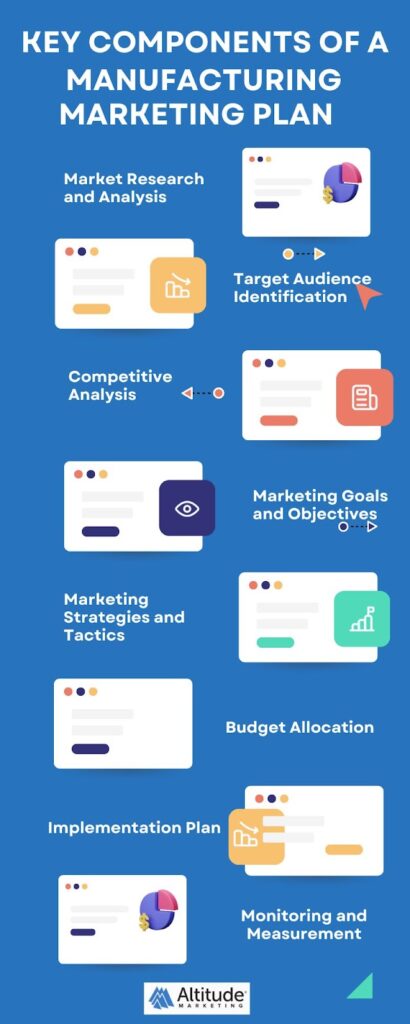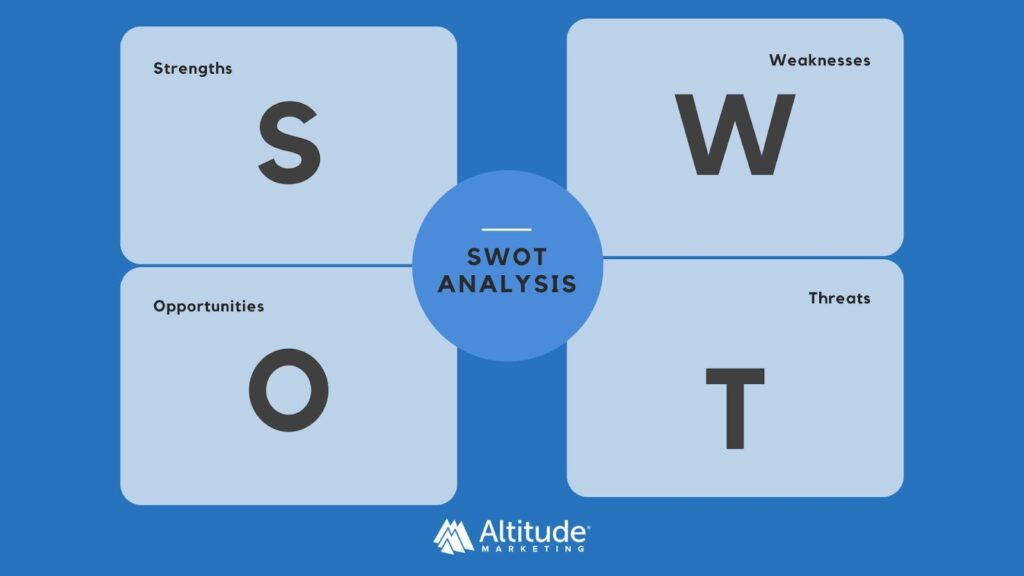For ages, manufacturing has traded on quality and relationships alone. But today, even the best products and friendships struggle to guarantee sales. With competition unyielding, superior solutions no longer speak for themselves. Marketing needs to step in to amplify potential and sharpen the competitive edge. But is it worth the investment, considering how costly it can be?
Absolutely! Effective marketing anchors manufacturing success. Though without a plan, random campaigns burn precious funds fast. Before any promotion, first, build foundations to support growth: your strategy. This article illuminates buyer’s pathways, framing the budget for impact. Still, questioning the costs? Let’s explore how to construct your manufacturing marketing master plan.
How to Build a Manufacturing Marketing Plan
Understanding Manufacturing Marketing
An authoritative marketing plan assesses the competitive landscape, defining strengths needing emphasis and gaps requiring solutions for your target audience. Research steers branding, lead generation, budget allocation and other fundamentals. With clarity on positioning, precise roadmaps guide tactics, outlining timelines for proposed campaigns like trade show presence, online advertising, email nurturing, and search engine optimization.
In short, a marketing plan cements the foundations for manufacturing business development success. It delivers ROI on promotions and anticipates challenges well in advance, ensuring activities sync up with long-term objectives. Right planning gives teams the confidence to execute. And that’s essential today, with growth demanding consistent innovation to beat competitors. Before rushing into new campaigns, construct your marketing blueprint. Smart preparation today aligns efforts for maximum impact tomorrow.
Why Manufacturing Companies Need a Well-Defined Marketing Strategy
Manufacturing companies – like any business – require a clearly defined marketing strategy. This is crucial to maintain competitiveness and sustainability. Here are some primary reasons;
Competition: The manufacturing industry is highly competitive which necessitates a marketing strategy to differentiate yourself.
Evolving buyer behavior: Modern B2B buyers and businesses heavily rely on research and digital platforms when making purchasing decisions. Having a marketing plan ensures that you have visibility where your buyers are actively searching.
Adaptation to market trends: A structured marketing plan enables manufacturers to adapt to shifting market trends and changing buyer preferences.
Educating buyers about solutions: Many buyers may not be aware of the value you offer as a manufacturer. This is why effective marketing plays a role in educating them about how your product or solution can address their pain points.
Building relationships with potential buyers: This is another advantage of engaging in marketing within the manufacturing industry. By creating content and actively interacting with buyers, it becomes possible to foster long-term relationships that can eventually translate into sales.
Supporting sales efforts: Marketing plays a role in equipping sales teams with the tools and compelling content to effectively convert leads into actual buyers.
Boosting sales figures: As a manufacturer, you might have products or services that you aim to enhance their sales performance. Achieving this can be facilitated through targeted marketing initiatives, such as tailored content and strategic utilization of sales channels that enable reaching out to prospects.
Nurturing buyer loyalty: Encourage brand loyalty in your marketing campaigns; it may be advantageous for you as a manufacturer to focus on fostering buyer loyalty and promoting repeat purchases. This can be accomplished by prioritizing buyer service experiences and implementing loyalty programs that incentivize buyers to choose your company for transactions.
Enhancing brand visibility: Effective marketing efforts significantly contribute to elevating brand recognition and reputation. For manufacturing companies, building brand awareness is particularly crucial since prospects might not be fully aware of the range of products or services from manufacturers.
Lead generation: Among the objectives of marketing campaigns is generation. However, this objective may pose challenges due to the involvement of decision-makers such as managing directors, sales directors, or heads of departments who play pivotal roles in the purchasing process.
To ensure success, generating content tailored to your audience and employing strategies for generating leads is crucial. Be sure to captivate their interest in your offerings, whether they be products or services.
Preparing for Your Manufacturing Marketing Plan
Before diving into marketing tactics, it’s important to set the groundwork for an effective manufacturing marketing plan. This preparation phase involves crucial internal homework across three areas:
1. Assessing your business – Take stock of your existing marketing assets, brand messaging, competitive positioning, and overall strategic objectives. Identify current gaps holding you back. This self-assessment establishes focus areas.
2. Understanding your audience – Thoroughly analyze your target buyer market and build detailed buyer personas. Document demographic and psychographic data, common pain points, and motivations during the purchase process. This effort should inform content creation and distribution strategies.
3. Evaluating your situation – Conduct a SWOT analysis to closely examine your company’s current standing. Assess internal strengths and weaknesses as well as external opportunities and threats from a marketing perspective. Look at digital adoption, channel presence, and asset needs. These insights guide priority areas.
| Preparation Area | Details to Cover |
| Assess Your Business | SWOT analysis of marketing capabilities. Assessment of strengths and weaknesses. Analysis of external opportunities and threats. Evaluation of digital adoption and presence. Inventory of current marketing channels and assets. |
| Understand Your Audience | Analysis of market demographics and behavior. Detailed buyer personas. Documentation of pain points and motivations in the sales cycle. |
| Evaluate Your Situation | SWOT analysis of marketing capabilities. Assessment of strengths and weaknesses. Analysis of external opportunities and threats. Evaluation of digital adoption and presence. Inventory of current marketing channels and assets. |
8 Components of a Manufacturing Marketing Plan

Market research is the foundation of any marketing plan in the manufacturing industry. It involves gathering data and insights about the industry, market trends, buyer preferences, and competitors. This information helps develop informed decisions and tailor your marketing efforts toward the current market conditions.
Market Research & Analysis
Thorough market research and analysis lay the foundation for an effective manufacturing marketing strategy. This involves conducting in-depth surveys, interviews, and focus groups to gain a nuanced understanding of the prospect’s pain points and needs. Competitive intelligence is also critical – secure rival products for hands-on examination of quality and functionality while dissecting their marketing assets to reverse engineer positioning. Tracking search engine and industry data trends over time spotlights evolving buyers’ interests and forecasts future demand. Advanced statistical models can also isolate market sensitivity to product pricing shifts, illuminating optimum margins.
Target Audience Identification
Precise target audience identification critically sharpens manufacturing marketing return on investment. Map existing buyer journeys end-to-end, tracing touchpoints across all stakeholder groups weighing in purchase decisions. Construct detailed buyer personas documenting everything from demographics to psychographics across roles spanning operations, IT, and finance. Rigorously quantify criteria for ideal buyer fit based on company size, growth goals, and potential lifetime value prioritizing those accounts accordingly. Plot their ecosystem of influence highlighting all touch points impacting satisfaction.
Competitive Analysis

Marketing Goals & Objectives
Sharp marketing plans align team priorities by connecting strategy to broader company financial targets and strategic goals. Apply actionable frameworks like S.M.A.R.T – setting specific, measurable, achievable, relevant goals anchored to realistic timelines. Simulation models strengthen credibility by projecting market response rates, while lead scoring systems allocate point values to prospect quality indicators critical for sales pipelines.
Consider the following S.M.A.R.T. goal example for a manufacturing company that specializes across key marketing objectives categories:
Objective: Market penetration
Specific Goal: Increase market share in a specific industrial sector by launching a new range of high-precision sensors
Measure: Increase market share by 20%
Achievable: Requires two partners
Relevant: It aligns with the company’s overall strategy
Timeline: Achieve the goal within 24 months of product launch
Manufacturing Marketing Strategies & Tactics
Multi-channel marketing strategies should map digital and offline tactics to each buyer journey stage – from early education content down to targeted product offers at the final miles. Media mix modeling guides ideal budget allocation across platforms based on projected performance and synergies, while continual martech expansion enhances segmentation capabilities. The storyboard nurtures journeys for each persona and plots associated content needed to drive conversions.
Budget Allocation for a Manufacturing Marketing Plan
Given sizable upfront production costs, demand granular media cost breakdowns from channel partners during negotiation to stress test budget tolerances. Compared to fixed spending, optimization leveraging marketing mix modeling dynamically shifts dollars to tactics demonstrating the best ROI. Monte Carlo simulations run thousands of market response permutations to build confidence that budgets accommodate acceptable levels of performance variance without excess waste.
Implementation Planning
With many multifaceted campaigns crossing platforms, sharp project management brings order to complexity mapping workflows from creative development and asset production down to final measurement. Detailed documentation covering activities, timelines, and milestones with owner accountability prevents execution issues while escalation pathways resolve inevitable roadblocks. Establish quality assurance review gates ensuring marketing copy, emails, and landing pages all align with branding guidelines.
Monitoring and Measurement
Consistent analytics offer the ultimate compass to refine manufacturing marketing strategy – but metrics carrying real meaning must map activities to overarching business KPIs. Instrument test cells across campaigns to quantify impact beyond correlation. Expand voice-of-buyer feedback loops via interviews and surveys, while custom executive dashboards structure data flows aligned to financial cadences. Follow the numbers for efficient spending and measurable growth.
Here are some example KPIs to track when building and executing a manufacturing marketing plan:
- Website Traffic – Track visits, unique visitors, page views, etc. to gauge engagement
- Lead Volume – Measure total new leads generated from campaigns
- Marketing Qualified Leads (MQLs) – Subset of leads that match target buyer personas
- Sales Qualified Leads (SQLs) – Leads sales deems viable opportunities to pursue
- Lead to buyer Conversion Rate – Percentage of leads that become buyers
- Cost Per Lead – Marketing spend divided by total leads to measure efficiency
- Sales Pipeline Generated – Total deal value of leads in sales funnel by source
- Win Rate by Source – Closed deals divided by leads from each channel
- Buyer Acquisition Cost – Total sales and marketing costs to acquire a new buyer.
- Buyer Retention Rate – Percentage of buyers retained period over period
- Buyer Lifetime Value – Revenue generated per buyer throughout the relationship
- Brand Awareness Lift – Increase in brand visibility and familiarity
- Social Media Engagement – Follower growth, shares, comments, clicks, etc.
- Content Consumption – Downloads, reads, time on page, clicks, conversions
- SEO Rankings – Keyword positions on search engines
Tracking metrics like these tied to both marketing activities and overarching business goals is crucial for optimizing manufacturing marketing plans. The key is choosing KPIs that map campaigns to revenue and growth.
With these core components fully developed and integrated under the marketing plan, manufacturing brands crystallize the most promising path to industry authority through buyer value.
4 Industry-Specific Considerations in Manufacturing Marketing
Marketing within the manufacturing industry presents both challenges and opportunities. Therefore, it is essential to address industry factors when developing a marketing strategy.
Sustainability & Environmental Impact
Manufacturers face increasing pressure to adopt practices and reduce their footprint due to growing environmental regulations and consumer expectations. Embracing sustainability can serve as a selling point. Implementing manufacturing practices, for instance, can differentiate your brand.
Impact of Emerging Technologies
Keeping up with evolving technologies can be demanding for manufacturing companies, especially smaller ones with limited resources. Embracing Industry 4.0 technologies like the Internet of Things, Artificial Intelligence, and automation can enhance efficiency and competitiveness. The global AI market is valued at $142.3 billion as of 2023. Therefore, it is crucial to highlight your advancements in your marketing campaigns as a testament to innovation.
Ethical Considerations & Compliance
Adhering to industry regulations, safety standards and ethical guidelines is paramount but often complex and resource-intensive. Demonstrating your commitment to manufacturing practices and compliance builds trust with prospects and partners. Thus, utilizing your marketing efforts to showcase adherence to industry standards becomes vital.
Buyer Experience Enhancement
Delivering buyer experiences is consistently important. It can be challenging within the manufacturing sector, where B2B relationships are prevalent. Prioritizing buyer-centric approaches in product development, service delivery, and communication strategies enhances buyer’s satisfaction levels. Focusing on building relationships will strengthen loyalty within this business-driven industry.
Navigating the market comes with its set of challenges, including the need to understand and adapt to diverse cultural norms, languages, and market dynamics.
However, there is also an opportunity to capitalize on this diversity by customizing your marketing messages and strategies in a way that resonates with cultures and regions. By creating content and running localized campaigns, you can effectively expand your reach.
Final Thoughts
A marketing blueprint centered on industry research, audience insights, and data-driven strategy differentiation steers manufacturing brands to new competitive heights in the contemporary climate. As emerging technologies and sustainability factors redefine production priorities over time, maintain vigilance through campaign measurement to double down on high-impact platforms.
Ultimately, substantive marketing conveys credible solutions, forging genuine prospect connections amid constant change. With vision anchored in both commercial capability and higher purpose, manufacturers drive transformation today to secure enduring marketplace leadership well into the future.



